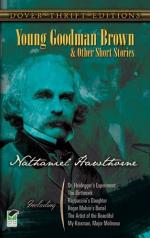|
This section contains 4,199 words (approx. 14 pages at 300 words per page) |

|
SOURCE: “‘Young Goodman Brown’: Hawthorne's Condemnation of Conformity,” in The Nathaniel Hawthorne Journal, 1978, pp. 137-45.
In the following essay, Matheson interprets “Young Goodman Brown” as Hawthorne's condemnation of a society that emphasizes conformity over spiritualism. Matheson argues that Brown's overriding concern for conformity, rather than a moral rejection of evil and sin, keeps him from joining with the Devil.
At first glance, it might appear farfetched to see Hawthorne's Goodman Brown as the spiritual ancestor of someone like Sinclair Lewis's Babbitt. Nevertheless, there is considerable evidence that the same preoccupation with social convention, public appearance, and conformity in general that characterized Lewis's twentieth-century protagonist is behind most of the speeches and actions of Hawthorne's seventeenth-century Puritan. Indeed, if Brown does lose the battle with the Devil for his soul, a case can be made that his lack of self-reliance is the most important contributing factor in his damnation...
|
This section contains 4,199 words (approx. 14 pages at 300 words per page) |

|


